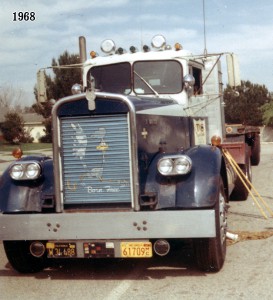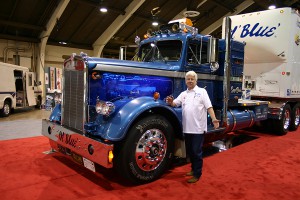 For more than 50 years, RJ Taylor has owned and operated ‘Ol’ Blue’™ – a 1951 (or is it a 1952) Kenworth that has become a legend in the trucking industry – whether he wanted to or not. And this rig has had an interesting life.
For more than 50 years, RJ Taylor has owned and operated ‘Ol’ Blue’™ – a 1951 (or is it a 1952) Kenworth that has become a legend in the trucking industry – whether he wanted to or not. And this rig has had an interesting life.
In 1964, the truck was forced upon Taylor, a veteran trucker and owner-operator, as a result of a court case. As the plaintiff in a lawsuit for monies owned to him ($4,800), the judge ruled in Taylor’s favor. All well and good, except the individual being sued didn’t have the funds to pay. He did, however, have a well-used tractor, which Taylor reluctantly had to settle for. “I tried to sell that old piece of junk, but had no takers,” recalls Taylor. “I couldn’t even get anyone to drive it!” But, such as it was, this was the beginning of what would become a life-long partnership.
Back in 1964, ‘Ol’ Blue’™ did not have all the modern conveniences of today’s trucks, like air conditioning, power steering, air-ride seats and suspension, high-horsepower engines and a single-stick transmission. Originally, ‘Ol’ Blue’™ was equipped with a NH 220 Cummins engine, a Spicer 5-speed main transmission box with a 3-speed brownie (commonly known as twin-sticks), along with Kenworth’s “torsion bar” suspension, and a pair of “drop-in” twin-screw rear-ends. The tires were 10.00 x 22 tube-types on Alcoa five-hole aluminum wheels.
At the time, Taylor owned and operated Van Nuys, California-based T&S Truck Lines. The company was hauling swing beef and general freight from Los Angeles to Dallas, Texas, and Las Vegas, Nevada. Following a year and a half of struggling to sell the old “court case award,” Taylor decided to rebuild the tractor and use it as a back-up until he managed to get it sold.
REMODELING
In 1966, Taylor looked for a sleeper that was lightweight and durable to replace the old heavy Arrow 36-inch sleeper that came with the truck. He found an outfit in Los Angeles, Mercury Sleeper Company, and asked them to build a special bunk that was only 28 inches long and 79 inches wide with a built-in headboard, which they did. Later, Taylor named the sleeper “Sugar Shack” and it became a unique feature on the rig because of its size and looks.
After getting the new sleeper, Taylor also added a “590” turbocharger to the 220 Cummins engine, which increased the horsepower to 262. Later that year, the old Kenworth “torsion bar” suspension and “drop-in” rears were replaced with a used Page & Page spring suspension and a U200 single-drive rear-end with a tag axle.
Later, in 1968, after the rig was refinished and repainted, Taylor hired Fred Lamont, “The best sign painter in the San Fernando Valley,” he said, to do the lettering on it. Taylor instructed Fred to paint “Born Free” on the bumper, since it was already on the grille. “I liked the song, Born Free by Roger Williams,” said Taylor, “because I could relate to the lyrics.” But, when finished, Taylor was shocked to see ‘Ol’ Blue’ on the bumper, instead. “What are you doing?” asked Taylor. “I’m trying to sell this truck and you’ve named it after a dog!” “The name will grow on you,” Fred calmly replied. “Leave it on.” Taylor did just that. And, like the sleeper, this became another unique feature on the truck.
In late 1968, Taylor decided to branch out his trucking business and get into heavy hauling. He bought a new 40-foot, lightweight, outside-frame Brown trailer to pull behind ‘Ol’ Blue’™. The tractor and trailer had a combined weight of only 22,500 pounds. He numbered the tractor “69” in hopes that potential heavy-haul customers would think it was a new truck. He then began making sales calls, boasting, “If you can build it, I can haul it. I can haul 50,000 pounds of freight, legally. If it’s over 50,000 pounds, I’ll get a permit.” Back then, most rigs could only haul 45,000 pounds of payload legally.
Now that Taylor was running this truck on a regular basis, some modern conveniences were added, including air conditioning, an air-ride seat, padded interior (instead of just cardboard), an AM/FM radio, a Mad Man Muntz 4-track tape player, and a Jake brake. In 1969, the engine in ‘Ol’ Blue’ was upgraded to a NH 250 Cummins with dual exhaust. Then, after adding the “590” turbo from the old NT 262, the engine became an NT 280. At the same time, the 3-speed brownie was replaced with a 4-speed and the old U200 rear-end was replaced with a new single-drive Eaton 1919 (still keeping the tag axle).
FAME COMES KNOCKING
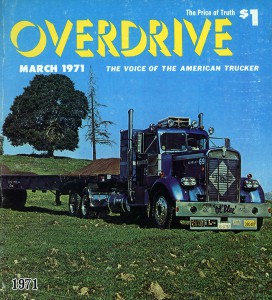 In 1971, the tractor that no one wanted became “famous” when ‘Ol’ Blue’™ made the front cover of Overdrive Magazine’s March issue, with a feature article on the truck and its unusual loads. At the time, Overdrive was the premier national publication for truck owner-operators. It wasn’t long afterwards that ‘Ol’ Blue’™ became the first commercial vehicle in the United States to get a personalized license plate (MR TS).
In 1971, the tractor that no one wanted became “famous” when ‘Ol’ Blue’™ made the front cover of Overdrive Magazine’s March issue, with a feature article on the truck and its unusual loads. At the time, Overdrive was the premier national publication for truck owner-operators. It wasn’t long afterwards that ‘Ol’ Blue’™ became the first commercial vehicle in the United States to get a personalized license plate (MR TS).
Always one for getting totally involved in anything he does, Taylor kept any eye out for ways to improve his new heavy-haul trucking operation. He helped design, and got, the first extendable trailer in Los Angeles, California. This trailer could stretch from 40 to 70 feet long.
In 1972, Doug Condra, Editor of Heavy Duty Trucking Magazine (HDT), asked Taylor if he could do a cover story with a 5-page feature article about the unique loads transported by ‘Ol’ Blue’™. Doug took the cover picture. This picture turned out so unusual, with a “halo” over the truck, he decided to use it for the December issue. The late Stan Holtzman took most of the photos used in this article of ‘Ol’ Blue’™ moving a steel truss that was 130 feet long for a new hanger at the Long Beach Airport.
LEGAL MATTERS
In 1972, Taylor went to California State Assemblyman Robert Cline for help in creating a law that would allow trucks hauling “long loads” – those under 100 feet – in the state to have flashing amber warning lights to provide a visual indication of a hazardous situation. Back then, it was illegal to have “whoopee lights,” as truckers referred to them, unless it was required for a long load permit. These permits were issued by city, county and state government agencies, and it was up to each entity’s discretion to allow the flashing amber warning lights, as there was no state law regulating these lights for long loads.
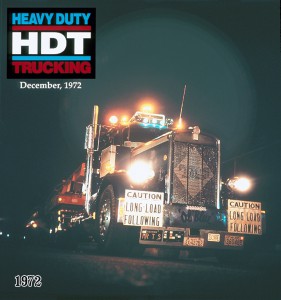 Because most over-length loads were moved at night, when traffic volume is reduced, Taylor believed that flashing lights would be a great aid to public safety. However, he had great difficulty getting lawmakers to understand the significant impact on collision avoidance and safety the lights could provide, especially when making turns, so he decided to show them.
Because most over-length loads were moved at night, when traffic volume is reduced, Taylor believed that flashing lights would be a great aid to public safety. However, he had great difficulty getting lawmakers to understand the significant impact on collision avoidance and safety the lights could provide, especially when making turns, so he decided to show them.
On a night move of a long-load haul through the city of Los Angeles, Taylor had a film crew follow ‘Ol’ Blue’™ and its extendable trailer, which was fully stretched out. The rig had an overall length of 92 feet. The crew filmed part of the move with the warning lights flashing, and part with the lights off. “The difference with the lights on and off was dramatic,” Taylor said. Back then, there were no mid-turn signals on tractors or trailers, and reflective tape on trailer sides was not yet required. “After watching the film, the lawmakers finally got the concept.”
Following a number of hearings that Taylor took part in, Assembly Bill 281, co-authored by him, was passed. On May 30, 1973, Governor Ronald Reagan signed it into California Law (VC 25275), “Warning Lamps on Trucks Primarily Engaged with Long Loads.” This law has never been amended and is still on the books.
UNIQUE LOADS
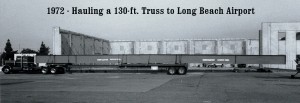 As the “fame” of ‘Ol’ Blue’™ grew, more invitations for unique hauls began coming into T&S Truck Lines. In June 1973, Taylor was called by the City of Van Nuys’ Chamber of Commerce and asked to be the first commercial carrier to transport the Apollo 14 command module. The space vehicle needed to be moved from the Rockwell facility in Downey, California, where it was being stored, to the Fourth of July Air Show at Van Nuys Airport, and back again.
As the “fame” of ‘Ol’ Blue’™ grew, more invitations for unique hauls began coming into T&S Truck Lines. In June 1973, Taylor was called by the City of Van Nuys’ Chamber of Commerce and asked to be the first commercial carrier to transport the Apollo 14 command module. The space vehicle needed to be moved from the Rockwell facility in Downey, California, where it was being stored, to the Fourth of July Air Show at Van Nuys Airport, and back again.
“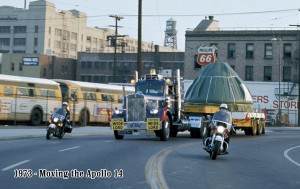 The Apollo move was done on all surface streets,” recollected Taylor. “We weren’t allowed on the freeways because the load was 14 feet wide and the law only allowed over-width loads of 12 feet.” The trip was 40 miles and took more than 2-1/2 hours. Thanks to the assistance of the California Highway Patrol, Los Angeles Police Department, the Los Angeles County Sheriff’s Department, the Air National Guard and people like John Quick, Sonny Niduvitch, Bosco Cope, Al Jones and Rick Walker, the haul was a success.
The Apollo move was done on all surface streets,” recollected Taylor. “We weren’t allowed on the freeways because the load was 14 feet wide and the law only allowed over-width loads of 12 feet.” The trip was 40 miles and took more than 2-1/2 hours. Thanks to the assistance of the California Highway Patrol, Los Angeles Police Department, the Los Angeles County Sheriff’s Department, the Air National Guard and people like John Quick, Sonny Niduvitch, Bosco Cope, Al Jones and Rick Walker, the haul was a success.
The week following the initial Apollo move, the City of Newhall (California) contracted ‘Ol’ Blue’™ to bring the Apollo 14 command module to the city’s 47th Annual Old West Parade. Once again, with the help of all the aforementioned departments and people, this second Apollo 14 move was yet another success.
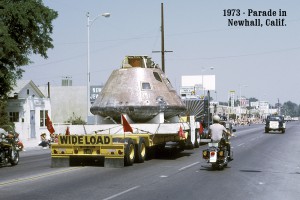 The following year (1974), ‘Ol’ Blue’™ moved 12-foot wide temporary buildings to the State Capital in Sacramento, California, for C.A. Buchen Corp. During one of his trips to the Capitol, Governor Ronald Reagan came out on the job site and re-signed the “Warning Light Law” on the left front fender of ‘Ol’ Blue’™.
The following year (1974), ‘Ol’ Blue’™ moved 12-foot wide temporary buildings to the State Capital in Sacramento, California, for C.A. Buchen Corp. During one of his trips to the Capitol, Governor Ronald Reagan came out on the job site and re-signed the “Warning Light Law” on the left front fender of ‘Ol’ Blue’™.
Then, the real “long one” came later that year from Ross-Carter Corp. It was a steel roof truss, 165 feet long, which needed to be taken to a church in Van Nuys, California. Once loaded on ‘Ol’ Blue’™ it would make it 185 feet long in overall length, with a rear overhang of 52 feet. This turned out to be the longest move in the state without a steerable trailer.
SITTING PRETTY
In early 1976, Taylor decided to repaint ‘Ol’ Blue’™ from the ground up, stripping it all, and starting from scratch. He turned to Ray Ramos of Ray’s Truck Painting in Los Angeles. Ray and Taylor worked alongside each other and a month later ‘Ol’ Blue’™ looked like a million bucks.
Wanting an aluminum deck between the sleeper and the trailer so his Iron Workers had a safe place to stand when steel was being lifted off his trailer, Taylor, again, turned to the Mercury Sleeper Company. This new deck was 6 feet long and 79 inches wide, with non-skid diamond plate finish and boxes on both sides. This deck became yet another unique feature on ‘Ol’ Blue’™.
TRADEMARKS
Around this time, Taylor was asked to show-off ‘Ol’ Blue’™ at truck beauty shows in the Southern California area. With help from neighborhood kids who washed, polished and ran errands, ‘Ol’ Blue’™ was taking home lots of trophies on the weekends and trucking during the week. Companies also started using photos of ‘Ol’ Blue’™ to sell their products, which did not make Taylor happy. “I don’t use your product so why make it look like I do?” To stop these companies from using pictures of ‘Ol’ Blue’™ Taylor filed for Registered Trademarks, and on May 12, 1977, ‘Ol’ Blue’ (#5447), “T/S” (#5446), and “Sugar Shack” (#5448) were officially trademarked. “Now, if you use a photo from the front or side of ‘Ol’ Blue’ I will sue you,” said Taylor. This is why you see a “TM” symbol every time the name ‘Ol’ Blue’™ is used.
DIVORCE DRAMA
In 1979, Taylor filed for divorce after a short 3-1/2 year marriage. This divorce got very nasty when the soon-to-be ex-wife counter-filed for half of everything Taylor had owned since birth – even ‘Ol’ Blue’™. This lawsuit dragged on until almost 1982, and after 32 hearings and a six-day trail, the estranged wife was awarded $25,000 with the stipulation that she does certain things. When she failed to satisfy these court orders, Taylor headed back to court. When it was all said and done, the divorce was finally final in 1985.
By this time, Taylor was broke with one foot in the bankruptcy court’s door and the engine in ‘Ol’ Blue’™ was now pumping water out the side of the block. The neighborhood kids, wanting to attend one more truck show, convinced Taylor to go anyways. On a Sunday morning, the kids, along with ten 5-gallon buckets of water they loaded into the back of a pickup which followed ‘Ol’ Blue’™, headed for Pomona, California, about 50 miles away. Stopping every 10 miles to add water to the radiator, ‘Ol’ Blue’™ and team made it to the show and took 1st place in the Specialty class. Boasting to Taylor, the kids said, “We told you we would win!” And they were right!
When Taylor got home from that show, he called all of his friends and said that he needed some help. Well, help came and Taylor was able to buy a used Cummins 400 Big Cam II for $6,000. ‘Ol’ Blue’™ and Taylor were back to work, and in the first month the duo made $20,000, paid everyone back, and got out of bankruptcy.
NEW AND IMPROVED
With its new and improved engine, ‘Ol’ Blue’™ could now play in the hills with the big boys. The Big Cam 400 had almost twice the torque at low rpms and delivered about 150 additional horses then the old NT 280 – and it was more reliable. Just to show it off, Taylor had this engine painted white with DuPont Imron paint. The following year, a decision was made to replace the old Spicer “twin sticks” (still in good condition) with a remanufactured Spicer 14-speed transmission to better handle the extra torque being created by the truck’s new Big Cam 400 under the hood.
TRUCK SHOWS
In October of 1985, Ol’ Blue, USA put on the first-ever truck safety contest at the King 8 Hotel & Truck Stop in Las Vegas, Nevada. How was this contest judged? Drivers were asked to enter their rig and be judged on how safe it was, not how pretty it looked.
In December of 1985, Taylor was asked if ‘Ol’ Blue’™ could be a special attraction at the Mid-America Trucking Show (MATS) in Louisville, Kentucky (March 1986) and the International Trucking Show (ITS) in San Francisco, California (April 1986). While at these shows, Taylor quickly realized that truck drivers needed help when they started asking him how he does his inspections on ‘Ol’ Blue’™ and how he avoided getting tickets in California. Taylor’s answer is simple: “Know your equipment like the back of your hand and fix things now – don’t drive until it’s fixed.”
On the first day of the ITS show, someone from the California Highway Patrol (CHP), which was situated across the aisle from ‘Ol’ Blue’™, asked why drivers were asking him questions and not the CHP. Taylor answered, “Truck drivers are not comfortable talking with CHP.” On the second day of the show, Taylor invited the CHP to work with ‘Ol’ Blue’™ and truckers began to feel comfortable talking with CHP. After the show, the CHP asked Taylor to start a non-profit public charity organization so they could begin working together to educate truckers and Ol’ Blue, USA (United Safety Alliance, Inc.) was born.
KENWORTH CONFLICTS
About the same time as Ol’ Blue, USA was formed, Stan Holtzman asked Taylor if he could do a 20” x 26” line drawing poster of ‘Ol’ Blue’™. Because Stan had never said no to any requests from Taylor, RJ happily agreed.
Around this same time, Taylor found out from Kenworth that ‘Ol’ Blue’™ was actually a 1951, not a 1952. After looking at photocopies of the build records, Taylor found that four serial numbers were never issued parts from Kenworth, #60662 through #60665 (‘Ol’ Blue’s serial number is #60662). Taylor contacted Kenworth and asked what happened, “I own a Kenworth with serial #60662 on the frame and cab plate. Are you telling me that my rig is not a Kenworth?” To that question, he got no answer.
A year later, in 1986, Taylor received a phone call from Stan saying that Kenworth was demanding 5% of every ‘Ol’ Blue’™ poster sold, and a $2,500 registration fee for using Kenworth’s registered trademark, “When Only the Best Will Do” on the poster. Taylor checked into Kenworth’s claim and found out that it was not a trademarked phrase. So, Taylor filed for it, and on June 12, 1986, “When Only the Best Will Do” was registered to RJ Taylor (#81553). After that, Kenworth agreed not to pursue the issue, and Stan’s poster continued to be sold.
FEDERAL SUPPORT
In February 1987, the Commercial Vehicle Safety Alliance (CVSA) and the United States Dept. of Transportation (USDOT) approached Taylor about working together to help truckers better understand the new inspection rules that were coming out in 1988 in most states. Could Ol’ Blue, USA get “free booth space” at truck shows across the country, they asked? Taylor asked CVSA and the USDOT who would be covering the travel and lodging expenses for the team and ‘Ol’ Blue’™ to do the shows, to which they said they would cover the costs with a $200,000 grant they had just received.
At the direction of Russ Fiste, Director of CVSA and James Bremner, Agent of the USDOT, Taylor called the shows and asked if they would like to have ‘Ol’ Blue’™ at their upcoming event? The answer was, “Yes, how much free space do you need?” Taylor called CVSA and the USDOT with the good news and was told, via phone, to book the space at all the shows. Bremner also asked Taylor if ‘Ol’ Blue’™ could display at the USDOT headquarters in Washington D.C. (March 1987) to show off what they were doing to improve highway safety and justify the new grant that CVSA received. Five shows were booked by Taylor: the East Coast Truck Show in Baltimore, Maryland (March 1987); the Crippled Children’s Working Truck Show in Pomona, California (April 1987); the Southern Trucking Show in Charlotte, North Carolina (May 1987); the Southwest Trucking Show in Dallas, Texas (June 1987); and the International Trucking Show (ITS) in Anaheim, California (July 1987).
TROUBLE IN PARADISE
Later that year, just before the Southern Trucking Show, things went to hell fast. CVSA and USDOT tried everything possible not to cover Ol’ Blue, USA’s expenses – they even tried to stick Ol’ Blue, USA with the hotel bill in Charlotte. On June 8, 1987, Ol’ Blue, USA sent a letter to CVSA and the USDOT that the outstanding expenses were $5,000 and if it was not paid by June 17, they could look for another sucker.
On June 17, Taylor contacted the Southwest Trucking Show in Dallas asking for a separate booth because CVSA and the USDOT were not covering their agreed-upon expenses, so the show agreed to have ‘Ol’ Blue’™ in another part of the show. On the first day, the CVSA/USDOT booth, filled with an owner-operator’s rig and troopers from North Carolina, was a flop.
That afternoon, in a meeting with Russ Fiste of CVSA and Bremner with USDOT, Fiste presented Ol’ Blue, USA with a personal check for $2,500 (half of what was owed) and promised to pay the balance in a week or so if they could all work together at the International Trucking Show (ITS) in July and be in the same booth. Taylor was suspicious, so he deposited the check that day.
As it turned out, Taylor had every right to be suspicious. The next week, Fiste tried to place a “stop payment” on this check and began trying to make a deal with ITS to give CVSA/USDOT the space that Ol’ Blue, USA had. Gary Sherrard at ITS said “no” and contacted Taylor to let him know what was going on. At that point, Ol’ Blue, USA cut ties with the CVSA and never got the $2,500 balance owed to them – to this day.
SAFETY CONTESTS
On September 4, 1987, Ol’ Blue, USA put on another truck safety contest at Sierra Sid’s 76 Super Truck-A-Rama in Sparks, Nevada. Bill Haley of Dumas, Texas won $1,800 in products and U.S. Savings Bonds. The following year, on April 22 and 23, in Ontario, California, Ol’ Blue, USA hosted another truck safety contest in the parking lot of the Union 76 Truck Plaza. This was the first time the CHP got involved in the judging of each rig, and this was also the first time this was not held during a “regular” truck show.
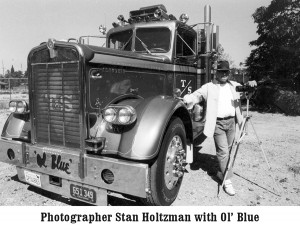 At this safety contest, drivers submitted an application with their name, driver’s license and vehicle license numbers, a list of tickets that they had received in the past three years, and agreed to have their truck and trailer inspected by the Ol’ Blue, USA team and CHP. Ol’ Blue, USA had an understanding with CHP that no tickets or out-of-service orders would be issued to the drivers or their trucks. The truck drivers were very skeptical, so Taylor told them, “This is my guarantee – if any driver gets a ticket or gets put out-of-service because you entered today, I will give you the pink slip on ‘Ol’ Blue’™.”
At this safety contest, drivers submitted an application with their name, driver’s license and vehicle license numbers, a list of tickets that they had received in the past three years, and agreed to have their truck and trailer inspected by the Ol’ Blue, USA team and CHP. Ol’ Blue, USA had an understanding with CHP that no tickets or out-of-service orders would be issued to the drivers or their trucks. The truck drivers were very skeptical, so Taylor told them, “This is my guarantee – if any driver gets a ticket or gets put out-of-service because you entered today, I will give you the pink slip on ‘Ol’ Blue’™.”
Despite rain on the second day, 75 drivers and tractor/trailers were judged. The winners received a U.S. Savings Bond: 1st place ($2,000) went to Carl Manning of Missoula, Montana; 2nd place ($1,250) went to Jack Anderson of West Covina, California; and 3rd place ($750) went to Gary Hagan from Minnesota.
On a positive note, at least 15 publications ran articles about the event, some with names and photos of the three winners. On a sad note, the California Attorney General in June came out with a ruling that the CHP could not inspect trucks at any event without issuing citations and placing vehicles out-of-service. If they see a violation, an officer must issue a citation or fix-it ticket. This was now mandated by California law.
STAY TUNED
Next month, we will have the conclusion of this two-part article, along with more pictures. For as much as RJ Taylor and his ‘Ol’ Blue’™ Kenworth (or is it not a Kenworth?) has already gone through so far here, there is still much more story to tell. Stay tuned!

